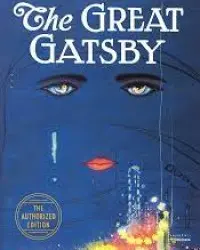The Cultural Effects of Modernity
God and Disillusionment in The Great Gatsby
April 7, 2023

The Great Gatsby is a dirge that mourns the death of the sublime in Western culture. This dirge can be said to start with God himself. Near the beginning, an old billboard is described which overlooks a wasteland left by industrial decay. On the billboard is painted the "eyes of Doctor T.J. Eckleburg". The eyes "look out of no face, but, instead, from a pair of enormous yellow spectacles which pass over a non-existent nose". T.J. Eckleburg is a motif that is present for much of the novel, with his involvement finding a climax when a character, driven mad by tragedy, claims that "God sees everything" while staring at the advertisement. Eckleburg has been identified with the moralistic elements of American society conflicting with the inevitable decay of progress. He has even been compared to God. The character's identification of God with Eckleburg makes the last interpretation the most likely. As has been shown, Fitzgerald reduces God to an advertisement: Eckleburg is implied to be omniscient and judging, yet infinitely less involved. This mustn't be taken to be a metaphysical statement per se, but rather a cultural statement. T.J. Eckleburg is God reduced to the material, modernist world.
But T.J. Eckleburg isn't the only casualty of modernity. Examining the titular character of Gatsby reveals a perversion of the archetypal Christ. The text itself states that Gatsby's persona was sprung "from his Platonic conception of himself", making him feel like "a son of God". These phrases from Fitzgerald suggest his desire to liken Gatsby to Christ. After all, Gatsby is a sacrificial character. He devotes his life to his lost love, Daisy Buchanan. But Daisy is hardly a worthy goal. By the end of the book, the reader finds she is more selfish than caring, a manifestation of the thoughtless privilege of the wealthy. Gatsby is ultimately a picture of the absurdity of a Christ whose goal is less than sublime. Just as Dostoevsky describes the need for a Christ to pursue a worthy goal, so too does Fitzgerald describe this need in his novel.
Indeed, as Gatsby is a perversion of Christ, Daisy Buchanan is the degradation of the ideals that make life meaningful. Gatsby lived in pursuit of the angelic ideal but found her to be a femme fatale. This theme of disillusionment is common to modernist literature.
The Buchanans are the consequences of a society where God is resigned to the role of Eckleburg: omniscient yet impotent.
There are four elements of The Great Gatsby. There is God in T.J. Eckleburg, Christ in the Gatsby, disillusionment in Daisy Buchanan, and impunitive living with the Buchanans. The modernist shifts in twentieth-century culture created these four elements of Fitzgerald's concise magnum opus.